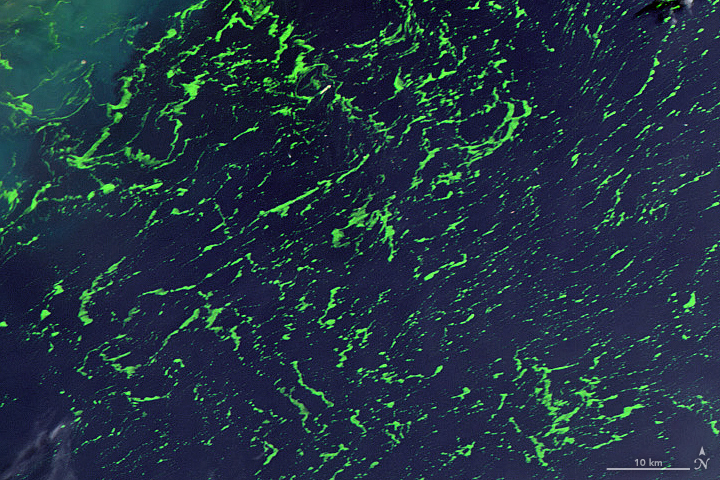

Algae made headlines around the world in June 2008 when an enormous bloom choked the coastal waters off Qingdao, China, the site of sailing events for that year’s Olympic Games. More than 700,000 tons of algae were cleared in time for competition that year, but similar “green tides” have returned every summer. In June 2021, algal slicks painted the Yellow Sea bright green during the region’s largest bloom on record.
The recent bloom is visible in this natural-color image, acquired on June 19, 2021, with the HawkEye sensor on the SeaHawk CubeSat. Images from SeaHawk and other satellites help scientists document the origin and distribution of blooms in the region as they work to untangle the factors causing the large outbreaks.
The species in the image is Ulva prolifera, a common green macroalgae (seaweed) that is not toxic to people or marine life; in fact, this “sea lettuce” is edible and nutritious. But long mats of it can still have detrimental effects on marine ecosystems. For example, decaying algae can deplete water of oxygen and cause “hypoxic” conditions that cause fish kills. The mounds of seaweed that wash up along the coastline can be unsightly and costly to remove.

According to Lin Qi, a remote sensing and marine scientist at University of South Florida (USF), blooms of Ulva prolifera typically start showing up in the western Yellow Sea in May, peak in June, and persist into July or August. Satellites have observed such blooms every year since 2007, with the first significant bloom reported in 2008.
The size of U. prolifera blooms fluctuates from year to year, but they have generally been increasing in size since 2012. Qi calculated that the bloom spanned more than 700 square kilometers (270 square miles) in June 2021—30 percent larger than the previous record in 2019.
Chuanmin Hu, also a marine scientist at USF, noted that most researchers agree that blooms of U. Prolifera originate around the vast aquaculture operations to the south off of Jiangsu Province. Notice the dark green slicks in the turbid water at the bottom of the wide image; according to Hu, these are the initial populations of seaweed.
Winds, tides, and human activity can cause some seaweed to detach from aquaculture rafts or other hosts. Currents and winds then can then carry them north to clearer water off Shandong Province, where ample light and nutrients fuel their growth into massive blooms.
Hu, Qi and other researchers are investigating what causes the inter-annual changes, but accurate estimates can be challenging. “This is more difficult than for many other blooms because human mitigation efforts can affect the evolution of a bloom within a season,” Hu said. But satellites like SeaHawk are making that task a bit easier.
“What’s really unique in this image is its optimal combination of coverage and resolution,” Hu said. “There are other satellite sensors that show the same bloom, but they are either too coarse in resolution or too narrow in coverage (with the exception of Sentinel-2 sensors). The HawkEye image shows the U. Prolifera slicks so vividly in one image, which can certainly reduce uncertainties when estimating bloom size.”
NASA image by Alan Holmes/NASA’s Ocean Color Web, using data from SeaHawk/HawkEye. Story by Kathryn Hansen.